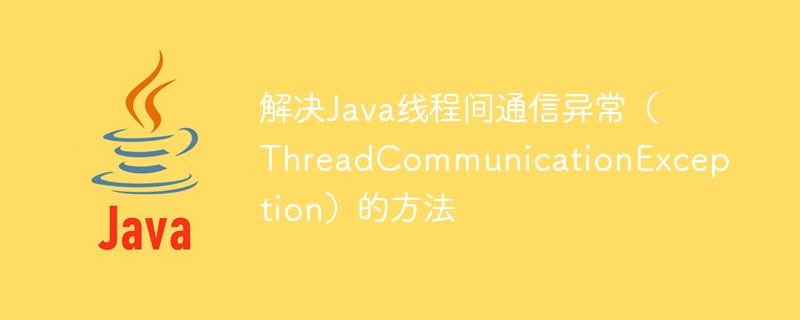解決Java執行緒間通訊異常(ThreadCommunicationException)的方法
- PHPz原創
- 2023-08-18 21:34:451301瀏覽

解決Java執行緒間通訊例外(ThreadCommunicationException)的方法
在Java程式中,執行緒間的通訊是非常常見的需求。然而,由於執行緒的並發執行特性,執行緒間通訊可能會出現異常,如ThreadCommunicationException。本文將探討如何解決這種異常,並給出對應的程式碼範例。
異常背景
在多執行緒程式設計中,不同執行緒之間需要共享資料或進行協作來完成任務。常見的線程間通訊方式有共享記憶體、訊息佇列、信號量等。然而,如果線程之間的通訊不當,就有可能出現線程安全問題,進而引發ThreadCommunicationException異常。
解決方法
要解決線程間通訊異常,可以採取以下措施:
- #使用互斥鎖(synchronized):互斥鎖可以保證在同一時間只有一個執行緒存取共享資源,從而避免了線程安全性問題。在Java中,可以使用synchronized關鍵字或lock物件來實現互斥鎖。以下是使用synchronized的範例程式碼:
public class ThreadSafeCounter {
private int count;
public synchronized void increment() {
count++;
}
public synchronized int getCount() {
return count;
}
}- 使用wait和notify方法:wait和notify方法是實現執行緒間協作的重要手段。 wait方法會使執行緒進入等待狀態,直到其他執行緒呼叫notify方法來喚醒它。以下是一個簡單的生產者-消費者模型的範例程式碼:
public class Buffer {
private int data;
private boolean available = false;
public synchronized void put(int value) {
while (available) {
try {
wait();
} catch (InterruptedException e) {
e.printStackTrace();
}
}
data = value;
available = true;
notifyAll();
}
public synchronized int get() {
while (!available) {
try {
wait();
} catch (InterruptedException e) {
e.printStackTrace();
}
}
available = false;
notifyAll();
return data;
}
}- 使用阻塞佇列(BlockingQueue):阻塞佇列是Java並發套件中提供的一種執行緒安全的佇列實現。它可以自動處理執行緒間的等待和喚醒操作,簡化了執行緒間通訊的程式碼。以下是使用阻塞佇列的範例程式碼:
public class Producer implements Runnable {
private BlockingQueue<Integer> queue;
public Producer(BlockingQueue<Integer> queue) {
this.queue = queue;
}
public void run() {
try {
while (true) {
Random rand = new Random();
int num = rand.nextInt(100);
queue.put(num);
System.out.println("Produced: " + num);
Thread.sleep(rand.nextInt(1000));
}
} catch (InterruptedException e) {
e.printStackTrace();
}
}
}
public class Consumer implements Runnable {
private BlockingQueue<Integer> queue;
public Consumer(BlockingQueue<Integer> queue) {
this.queue = queue;
}
public void run() {
try {
while (true) {
int num = queue.take();
System.out.println("Consumed: " + num);
Thread.sleep(new Random().nextInt(1000));
}
} catch (InterruptedException e) {
e.printStackTrace();
}
}
}程式碼範例中,Producer類別負責生產資料並放入阻塞佇列,Consumer類別負責消費資料。它們透過阻塞佇列實現了線程間的安全通訊。
結語
執行緒間通訊是多執行緒程式設計中的重要問題,如果不正確處理,就可能導致執行緒安全性問題和例外(如ThreadCommunicationException)。本文介紹了使用互斥鎖、wait和notify方法以及阻塞佇列來解決線程間通訊異常的方法,並給出了相應的程式碼範例。希望讀者能從本文中獲得一些有用的信息,並在實際開發中減少線程通訊異常的發生。
以上是解決Java執行緒間通訊異常(ThreadCommunicationException)的方法的詳細內容。更多資訊請關注PHP中文網其他相關文章!
陳述:
本文內容由網友自願投稿,版權歸原作者所有。本站不承擔相應的法律責任。如發現涉嫌抄襲或侵權的內容,請聯絡admin@php.cn

